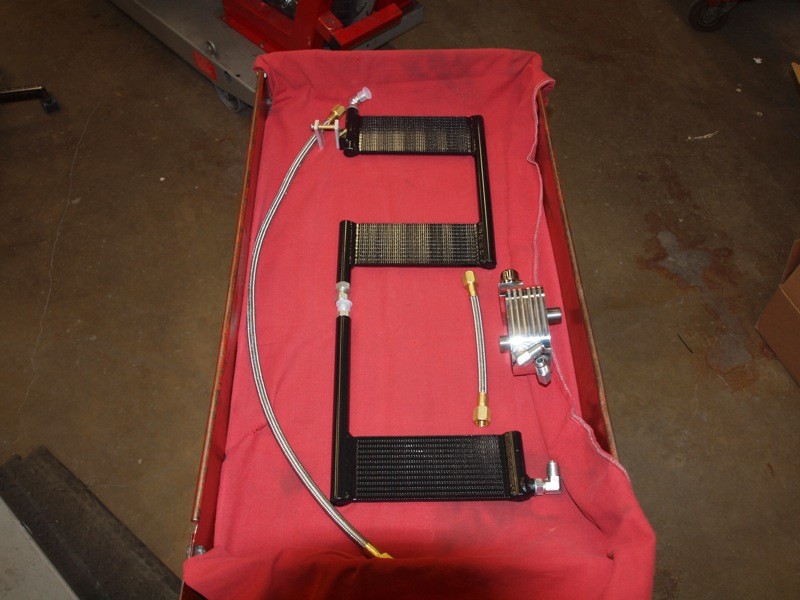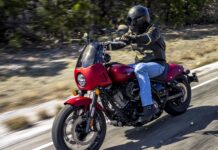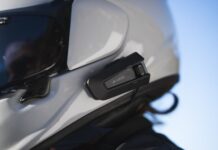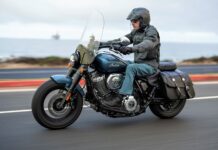Over the years, Harley-Davidson Twin Cam motor temperatures have gotten higher and higher due to more restrictive EPA standards. Harley has had to run their motors with leaner and leaner fuel mixtures to meet these standards. When I had my 2001 Heritage the oil temperature rarely got above 200 degrees. Fast-forward to today and it is not uncommon to see temps running in the 280-degree range. I can remember riding across Nebraska on I-80 two years ago with the air temperature at 109 degrees. My oil temperature was approaching 300 degrees so I just pulled off the highway and called it a day since the inside of my legs felt like bacon frying in a pan and I was afraid of damaging my motor. Heat can be a motor’s worst enemy.
When I purchased my 2013 Road Glide I started looking for aftermarket oil coolers, all of which claim to cool the engine significantly. While doing my research I came across the Oil Bud Oil Cooler system. It sounded good, but I’m a skeptic when it comes to aftermarket parts.
I perused the Oil Bud website and saw a lot of impressive things about their cooler. This cooler was inspired by aircraft technology, built from aircraft-quality materials. This intrigued me since I had made my living as a commercial pilot for 35 years and know what kind of quality goes into aircraft parts and the high standards they must meet. The Oil Bud consists of stainless hoses along with a 6061-T6 aluminum extrusion and welded-in header-tank assembly. Why was this oil cooler built to these high standards? Bud Clark, designer of the Oil Bud, is in the aircraft business (Clark Manufacturing) and an avid rider. He builds kit aircraft like the Lance Air 14 and does major aircraft modifications in his Helena, Montana, shop.
Bud claims his oil cooler will reduce oil temperature by as much as 35 degrees and works in stop-and-go traffic, but I still had questions. Since the oil cooler is mounted between the frame rails below the oil pan it can be hit by stones and other road hazards. Can it be damaged? All one has to do is go to the Oil Bud website and you will see videos of Bud shooting the Oil Bud with a 12-gauge shotgun and then pressure testing it to 150 PSI with no leaks. If that is not enough, Bud used a five-pound hammer on it and still could not make the Oil Bud fail. I also asked how to change my oil if the cooler is mounted under the oil pan. The answer: “just like I always have.” The cooler will not interfere with the drain plug and you can still use your jack since the Oil Bud mounts between the frame rails.
When my Oil Bud arrived I opened the box to find a very high-quality part. After examining the contents of the box, I read the instructions, which were easy to follow with a photo of each installation step. Bud told me that for a first-time install, it should take anyone with average mechanical ability about 90 minutes to complete, and after that most will do it in 45 minutes.
Instead of doing the install myself I decided I wanted a qualified Harley tech to do it so I could get an expert opinion on the cooler and ease of installation. I contacted Mike Bober, service manager at South East Harley-Davidson in Cleveland, Ohio, and asked if he could have one of his techs do the install. Mike said he would be happy to do it.
When I arrived at South East H-D Mike assigned his lead tech Greg Lucak to do the install. Greg has been with South East H-D for 28 years, so who better to do the install and give an honest opinion? After getting the bike on the lift Greg looked through the parts and then read over the instructions. I will not go over a step-by-step install here since everything required was straightforward. It took Greg about 90 minutes and the Oil Bud was on the bike. I think he could have done it a little faster if I had not been there to “help” and get in the way taking pictures. Greg said he was sure he could do it in 45 minutes the next time and that the install was easy to do. One note: If you have an oil temperature gauge on your bike, let Bud know when you order your cooler so he can send an Allen head plug along since you will have to relocate the temperature sensor from the pan to the Oil Bud adapter plate.
After the install Greg took the bike for a test ride to make sure there were no leaks. Quite a while later Greg returned and I asked if there had been a problem since he had been gone for so long. He said the only problem he had was getting the oil temperature up 200 degrees. The outside air temperature this day was 65 degrees, which is not really hot. The thermostat begins to open at 185 degrees and is fully open at 200 degrees. On the 20-mile ride home my oil temperature never got above 195 degrees. Now all I needed was a hot day to give it a real test on both the road and in traffic.
A month later, on a sunny, 81-degree day, I took the bike on a 100-mile ride on the Interstate and the temperature held at 195. From past experience my oil temperature would have been running around the 230 mark. Impressive, but I still wanted to see how it would work in city traffic. I pulled off the Interstate and rode down one of the city streets in stop-and-go traffic. I carefully watched the oil temperature gauge, which never displayed above 210. Now for the final test—back on the Interstate and up to highway speed to see if the temperature would go back down. The next exit was just three miles away and by the time I got there the oil temperature was back to 195. Yet another reason to be impressed. If you are considering an aftermarket oil cooler that is easy to install and lives up to its claims, I would recommend checking out the Oil Bud.





















Where can I get parts for my oil Bud, oil is leaking from the fitting that goes into the flange
Douglas,
I just saw your comment now, otherwise I would have commented earlier! Hit us up either through the Contact page on our site or give us a call (406-457-2458) and we can get you fixed right up!
Bil
Ive been wrenching on HD’s since 1972 and for HD there’s is nothing to brag about…Sure some are classic…But for today? it’s all about getting the bike back to the dealership on just about every thing…Well for me I can say what KILLS a engine is HEAT…now today HD is saying 260 to 270 degrees is the norm…Well I say BS…If you don’t control the heat on a HD you will short live that engine…The New Engines Today after 260 degrees drops the rear cylinder on fuel…If you want to stop dropping the rear cylinder?…then you will have to keep the Oil Temperarture Down below 260 degrees…That’s where the Bud Oil Cooler comes in…It will keep the Engine Oil Temperarture Down around 200…where it belongs..less wear..longer life…I have Not found another oil cooler on the market that Keeps The Oil Temp Down around 200 no where…and I have tested a lot of them since 1972…Bud Oil Coolers Work…and built to last the test of Heat as well as Time on your Engine.
Florida is a real proving ground for an oil cooler. We have summers hitting 100 degrees with humidity thick enough to cut with a butter knife. My 2015 FLSTC Softail usually ran at a steady 250 oil temperature and approached close to 300 in heavy stop-and-go traffic. I agree with all previous comments…that is way too damn hot for an engine. After the Oil Bud was installed, some long 100+ mile rides in Florida summer kept the temperature just below 220 even in heavy traffic. This makes a believer out of me. I’m tired of sitting on top of a furnace waiting for nuclear meltdown. Oil Bud works and is the best insurance you can buy for a Twin-cam.
Insanely comprehensive 🙂
Thank you so much,
Now I have something to read during the holidays. This will take a while but well worth it like always
You can read another one here themotorbiker
Will you call me at 412-877-8132, need this oil cooler because the 2015 custom 1200 do sportscaster does run hot. Almost 310 degrees. Would like to know which one fits and if they are available